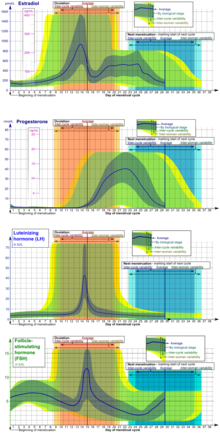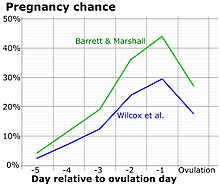Ovulation
| Ovulation | |
|---|---|
 Following a surge of luteinizing hormone (LH), an oocyte (immature egg cell) will be released into the uterine tube, where it will then be available to be fertilized by a male's sperm within 12 hours. Ovulation marks the end of the follicular phase of the ovarian cycle and the start of the luteal phase. | |
| Identifiers | |
| MeSH | D010060 |
| TE | E1.0.0.0.0.0.7 |
| Anatomical terminology | |
Ovulation is the release of
Process


Ovulation occurs about midway through the
The process of ovulation is controlled by the
Follicular phase
The
For ovulation to be successful, the ovum must be supported by the corona radiata and cumulus oophorous granulosa cells.[13] The latter undergo a period of proliferation and mucification known as cumulus expansion. Mucification is the secretion of a hyaluronic acid-rich cocktail that disperses and gathers the cumulus cell network in a sticky matrix around the ovum. This network stays with the ovum after ovulation and has been shown to be necessary for fertilization.[14][15]
Ovulation
Estrogen levels peak towards the end of the follicular phase, around 12 and 24 hours. This, by positive feedback, causes a surge in levels of luteinizing hormone (LH) and follicle-stimulating hormone (FSH). This lasts from 24 to 36 hours, and results in the rupture of the ovarian follicles, causing the oocyte to be released from the ovary.[16]
Through a signal transduction cascade initiated by LH, which activates the pro-inflammatory genes through cAMP secondary messenger,
By this time, the oocyte has completed
The precise moment of ovulation was captured on film for the first time in 2008, coincidentally, during a routine hysterectomy procedure. According to the attending gynecologist, the ovum's emergence and subsequent release from the ovarian follicle occurred within a 15-minute timeframe. [18]
Luteal phase
The follicle proper has met the end of its lifespan. Without the oocyte, the follicle folds inward on itself, transforming into the
Clinical presentation
The start of ovulation may be detected by signs that are not readily discernible other than to the ovulating female herself, thus humans are said to have a concealed ovulation.[20] In many animal species there are distinctive signals indicating the period when the female is fertile. Several explanations have been proposed to explain concealed ovulation in humans.
Females near ovulation experience changes in the
Many females experience heightened sexual desire in the several days immediately before ovulation.[26] One study concluded that females subtly improve their facial attractiveness during ovulation.[27]

Symptoms related to the onset of ovulation, the moment of ovulation and the body's process of beginning and ending the menstrual cycle vary in intensity with each female but are fundamentally the same. The charting of such symptoms — primarily basal body temperature, mittelschmerz and cervical position — is referred to as the sympto-thermal method of fertility awareness, which allow auto-diagnosis by a female of her state of ovulation. Once training has been given by a suitable authority, fertility charts can be completed on a cycle-by-cycle basis to show ovulation. This gives the possibility of using the data to predict fertility for natural contraception and pregnancy planning.
Urine levels of the hormone pregnanediol 3-glucuronide of over 5 μg/mL has been used to confirm ovulation. This test has a 100% specificity over 107 women.[29]
Disorders
Disorders of ovulation, also known as ovulatory disorders are classified as menstrual disorders and include oligoovulation (infrequent or irregular ovulation) and anovulation (absence of ovulation):[30]
- Oligoovulationis infrequent or irregular ovulation (usually defined as cycles of greater than 36 days or fewer than 8 cycles a year)
- dysfunctional uterine bleeding).
The World Health Organization (WHO) has developed the following classification of ovulatory disorders:[31]
- WHO group I: Hypothalamic–pituitary–gonadal axis failure
- WHO group II: Hypothalamic–pituitary–gonadal axis dysfunction. WHO group II is the most common cause of ovulatory disorders, and the most common causative member is polycystic ovary syndrome (PCOS).[32]
- WHO group III: Ovarian failure
- WHO group IV: Hyperprolactinemia
Menstrual disorders can often indicate ovulatory disorder.[33]
Ovulation induction
Ovulation induction is a promising
A low dose of human chorionic gonadotropin (HCG) may be injected after completed ovarian stimulation. Ovulation will occur between 24 and 36 hours after the HCG injection.[34]
By contrast, induced ovulation in some animal species occurs naturally, ovulation can be stimulated by coitus.[35]
Ovulation suppression
In
Fertility and timing of ovulation
Most women who are able to conceive are fertile for an estimated five days before ovulation and one day after ovulation.[38] There is some evidence that for couples who have been trying to conceive a child for less than 12 months and the female is under 40 years old, practicing timed intercourse (timing intercourse with ovulation using urine tests that predict ovulation) may help improve the rate of pregnancy and live births.[38] The role that stress plays in ovulation, fertility, and understanding the biological basis for stress-induced anovulation and the role of cortisol is not entirely clear.[39]
See also
- Anovulatory cycle
- Corpus luteum
- Folliculogenesis
- Menstrual cycle
- Oogenesis
- Mittelschmerz
- Fertilisation
Notes
- ^ Ovulation Test Archived 2016-05-02 at the Wayback Machine at Duke Fertility Center. Retrieved July 2, 2011
- ISBN 9780443068508. Retrieved 2013-11-09.
- ^ "How to Chart Your Menstrual Cycle". WebMD. Retrieved 2021-07-29.
- ISBN 9788131211502. Retrieved 2013-11-09.
- ISBN 9780472030279. Retrieved 2013-11-09.
- ISBN 9780618755714. Retrieved 2013-11-09.
- ISBN 9782884491716. Retrieved 2013-11-09.
- ^ S2CID 29063110.
- ^ ISBN 9780321887603.
- PMID 10362823.
- ISBN 9781401811921. Retrieved 2013-11-09.
- ISBN 9780123820334. Retrieved 2013-11-09.
- ^ "Cumulus Oophorus - an overview". sciencedirect.com. 2012. Retrieved 2023-05-22.
- ^ "Can You Get Pregnant after Ovulation?". coveville.com. 2015-02-03. Retrieved 3 Feb 2015.
- ^ "Fertilization: your pregnancy week by week". medicalnewstoday.com. Retrieved 15 Feb 2016.
- ISBN 9780313391750. Retrieved 2013-11-09.
- PMID 3087519.
- ^ "Ovulation moment caught on camera". BBC News. 2008-06-12.
- ^ "Usually, it occurs between the 10th and 20th day of your menstrual cycle". momjunction. Retrieved 26 July 2016.
- ^ Smith, Yolanda; Pharm, B. (2010-04-27). "Ovulation Signs". News-Medical.net. Retrieved 2023-05-22.
- S2CID 46065468.
- ISBN 9780781788076. Retrieved 2013-11-09.
- ^ "Ovulation Pain: Symptoms, Causes & Pain Relief". Cleveland Clinic. Retrieved 2021-07-29.
- ^ "Am I Ovulating? How to Spot the Signs". WebMD. Retrieved 2021-07-29.
- ^ "Ovulation cramps: Symptoms and what they mean for fertility". www.medicalnewstoday.com. 2020-06-18. Retrieved 2021-07-29.
- S2CID 40401379.
- PMID 15503991.
- PMID 10402400.
- S2CID 20604171.
- ISBN 9789387162303.
- ISBN 978-0-19-920380-2.
- PMID 22611175.
- OCLC 1083163793.
- ^ a b c IVF.com > Ovulation Induction Archived 2012-02-26 at the Wayback Machine Retrieved on Mars 7, 2010
- S2CID 873489.
- OCLC 781956734. pp. 257–258
- PMID 22078182.
- ^ PMID 37709293.
- PMID 37455908.
Further reading
- Baerwald AR, Adams GP, Pierson RA (July 2003). "A new model for ovarian follicular development during the human menstrual cycle". Fertility and Sterility. 80 (1): 116–22. PMID 12849812.
- Chabbert Buffet N, Djakoure C, Maitre SC, Bouchard P (July 1998). "Regulation of the human menstrual cycle". Frontiers in Neuroendocrinology. 19 (3): 151–86. S2CID 40594356.
- Fortune JE (February 1994). "Ovarian follicular growth and development in mammals". Biology of Reproduction. 50 (2): 225–32. PMID 8142540.
- Guraya SS, Dhanju CK (November 1992). "Mechanism of ovulation--an overview". Indian Journal of Experimental Biology. 30 (11): 958–67. PMID 1293040.
- Klowden MJ (2009). "Oviposition Behavior". In Resh VH, Carde RT (eds.). Encyclopedia of Insects. Academic Press. ISBN 9780080920900. Retrieved 2013-11-09.
- Su HW, Yi YC, Wei TY, Chang TC, Cheng CM (September 2017). "Detection of ovulation, a review of currently available methods". Bioengineering & Translational Medicine. 2 (3): 238–246. PMID 29313033.
